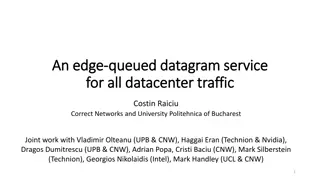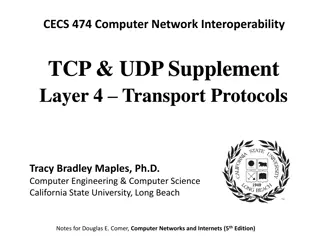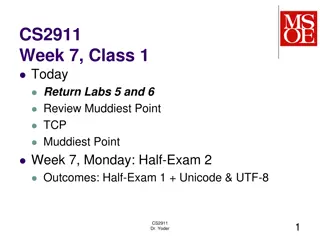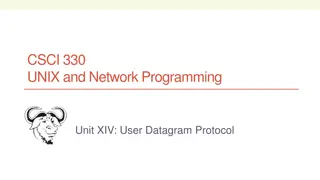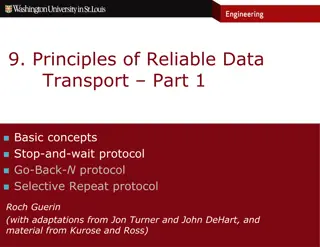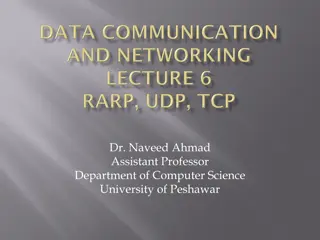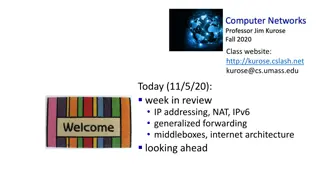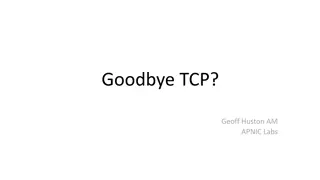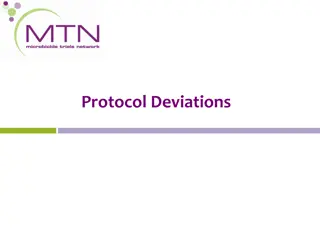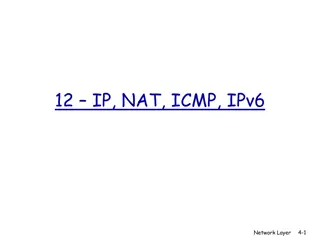Understanding Reliable Transport and User Datagram Protocol in Computer Networking
This content covers the concepts of reliable transport in computer networking, including the reliable transport layer protocols like TCP, UDP, and the basics of Domain Name Service (DNS). It explains the layers of the Internet, the functions of each layer, and the differences between TCP and UDP protocols. The information shared includes diagrams, slides, and headers related to transport protocols, domain names, and layers in networking.
Download Presentation

Please find below an Image/Link to download the presentation.
The content on the website is provided AS IS for your information and personal use only. It may not be sold, licensed, or shared on other websites without obtaining consent from the author. Download presentation by click this link. If you encounter any issues during the download, it is possible that the publisher has removed the file from their server.
E N D
Presentation Transcript
1 CS-340 Introduction to Computer Networking Lecture 5: Reliable Transport Steve Tarzia Many diagrams & slides are adapted from those by J.F Kurose and K.W. Ross
2 Last Lecture: Domain Name Service DNS is the Internet s directory service It s distributed and hierarchical 13 Root servers are run by ICANN Top level domain (TLD) servers manage com, org, edu, cn, au, uk, etc. Each subdomain has a set of authoritative nameservers Various types of records exist to do more than just map name IP Domain registrars are accredited by each TLD to sell names. Dynamic DNS servers can cleverly craft their responses to provide: Load balancing and fault tolerance in a cluster of servers Content Delivery Networks, that direct you to the closest service mirror Captive portals
3 Recall the four main layers on the Internet Ethernet Frame MAC addresses, CRC, etc. IP Packet IP addresses, TTL, etc. TCP Segment Port #, sequence #, ack #, etc. HTTP Response status code, content-type, etc. Ethernet Frame MAC addresses, CRC, etc. IP Packet IP addresses, TTL, etc. TCP Segment Port #, sequence #, ack #, etc. HTTP Response Continued Ethernet payload IP payload TCP payload TCP payload continued <html><body><h1>My great page</h1><p> and that is all</p> </body></html>
4 Each layer solves a subset of problems Link layer: shares a physical channel among several transmitters/receivers Network layer: routes from source to destination, along many hops. Transport layer: Creates connections/sockets used by apps. Multiplexing (>1 connection per machine) Ordering, Acknowledgement, Pacing HTTP layer: Resource urls, Response codes, Caching, Content-types, Compression None of the layers shown provide security. Ethernet Frame MAC addresses, CRC, etc. IP Packet IP addresses, TTL, etc. TCP Segment Port #, sequence #, ack #, etc. HTTP Response status code, content-type, etc. Ethernet payload IP payload TCP payload <html><body><h1>My great page</h1><p>
5 User Datagram Protocol (UDP) The simplest transport protocol on the Internet (simpler than TCP). transport was a bad naming choice. Does not provide much more than the IP layer below. Datagrams are packets sent between software applications. IP layer provides best effort delivery. Packets may be dropped. Thus, UDP is also unreliable. Adds to each packet: A port number, to distinguish different services on the machine. Only one process can listen for packets on a given port number. A checksum to verify that packet data was not corrupted.
6 UDP header fields 32 bits source port # length dest. port # checksum length, in bytes of UDP packet, including header application data (payload) UDP packet format
Checksum is a simple way to detect data corruption 7 Break the data into a sequence of 16-bit integers Add the integers Wrap the carry-out bits to the least-significant position. Finally, invert the result. Checksum is redundant information a summary of the packet data. 1 1 1 1 0 0 1 1 0 0 1 1 0 0 1 1 0 1 1 1 0 1 0 1 0 1 0 1 0 1 0 1 0 1 wraparound 1 1 0 1 1 1 0 1 1 1 0 1 1 1 0 1 1 1 1 0 1 1 1 0 1 1 1 0 1 1 1 1 0 0 1 0 1 0 0 0 1 0 0 0 1 0 0 0 0 1 1 sum checksum
8 Checksum in action Sender wants to send data: Hello there, here is my message. UDP library in the sender computes a checksum as follows: He + ll + o + th + er + e, + h + er + e + is m + y + me + ss + ag + e. = 0xB51 Wrap around: 0x51 + 0xB = 0x5C Flip bits: 0101 1100 1010 0011 = 0xA3 Sender adds 0xA3 checksum to UDP header of the packet. Receiver wants to verify the following message: Hello there, here is my massage. UDP packet s checksum says checksum is 0xA3. Receiver calculates checksum of the received message, and finds that it does not equal 0xA3 (because a bit was flipped). Receiver drops the packet. Checksum does not repair errors, it simply lets us detect errors.
10 TCP provides streaming connections to apps TCP is usually implemented by the OS. An OS library handles the following: Ordering: Data must be packetized (chunked) by the sender and reassembled by receiver Reassembly is done in the proper order, regardless of delivery order. Acknowledgement: (almost, but not exactly reliability ) Delivery of each packet is acknowledged, so lost packets can be retransmitted. Pacing: Sender adjusts packet send rate so neither receiver nor network are overwhelmed. Avoid filling up queues and dropping packets. TCP deals with many underlying Internet problems: Packet loss/corruption (ack./checksum) Finite link speed & Q size (flow & congestion control) Packet reordering (seq. numbers) Finite packet size (seq. numbers)
11 Human solutions to message loss STOP and THINK How do people deal with "message loss" on the telephone? Listener may say OK or mm-hmm after each sentence. Called positive acknowledgement or ACK. If talker does not hear an ACK, then maybe she repeats herself, or asks are you still there? Listener may say What? or Can you repeat that? if message was corrupted or lost. Called negative acknowledgement or NACK. Talker retransmits the message in response. What happens if acknowledgements are lost? Positive: talker cannot make progress, gives up. Negative: listener cannot recover missed messages, gives up.
12 Na ve ACKs receiver sender receiver sender send pkt0 pkt0 send pkt0 pkt0 rcv pkt0 rcv pkt0 send ack0 ack0 send ack0 rcv ack0 send pkt1 ack0 rcv ack0 send pkt1 pkt1 X pkt1 loss rcv pkt1 send ack1 ack1 rcv ack1 pkt2 timeout resend pkt1 send pkt2 rcv pkt2 send ack2 pkt1 ack2 rcv pkt1 send ack1 ack1 rcv ack1 pkt2 send pkt2 rcv pkt2 send ack2 ack2 (a) no loss (b) packet loss
13 Na ve ACKs (continued) receiver sender send pkt0 receiver sender send pkt0 pkt0 rcv pkt0 pkt0 send ack0 ack0 rcv pkt0 rcv ack0 send pkt1 send ack0 ack0 pkt1 rcv ack0 send pkt1 rcv pkt1 send ack1 pkt1 rcv pkt1 send ack1 ack1 ack1 X loss timeout resend pkt1 rcv ack1 pkt1 rcv pkt1 timeout resend pkt1 pkt1 (detect duplicate) send ack1 rcv pkt2 send ack2 rcv pkt2 (detect duplicate) pkt2 rcv pkt1 send pkt2 (detect duplicate) send ack1 ack1 ack1 rcv ack1 ack2 rcv ack1 send pkt2 pkt2 pkt2 send pkt2 rcv pkt2 send ack2 ack2 ack2 send ack2 (d) premature timeout/ delayed ACK (c) ACK loss
Nave ACK correctness 14 Solves packet loss/corruption, and ordering Do not send packet n until we get ACK n-1. Timeout is necessary to decide when a packet is lost Sender cannot ever really know the status of a packet, unless got an ACK. If timeout is premature, then sender may retry too soon. That s OK because both sender and receiver can simply discard old/duplicate packets: If sender already got ACK n, then there is no need to send packet n in response to ACK n-1. If receiver already got packet n, then there is no need to send ACK n-1 in response to packet n-1. At most, twice the necessary data will be in flight.
15 Na ve ACK performance It s a stop and wait protocol. Round-trip time (RTT) of packets dominates performance. Eg., An ISP s fiber link from New Jersey to San Jose, CA: 1 Gbps link, 15 ms propagation delay, 1.5 kByte packet size: RTT = 2 (15 ms + 1.5 kByte * 8 bit/Byte / 1 Gbps) = 30.01 ms RTT is dominated by the 30 ms round-trip propagation delay. Effective throughput is just 1.5 kByte * 8 bit/Byte / 30.01 ms = 250 kbps Performance with ACKs is 4000 slower than without ACKs.
16 Stop and wait illustration sender receiver first packet bit transmitted, t = 0 last packet bit transmitted, t = L / R first packet bit arrives last packet bit arrives, send ACK All this time is idle and wasted. RTT ACK arrives, send next packet, t = RTT + L / R
Pipelining hides latency to increase throughput 17 Pipelining: allow multiple in-flight packets, not yet ACK-ed. A buffer is a queue of data waiting to be consumed. Packet buffering & acknowledgement become more complex. Later we ll talk about flow/congestion control to prevent overwhelming the receiver/network.
18 Pipelining increases link utilization sender receiver first packet bit transmitted, t = 0 last bit transmitted, t = L / R first packet bit arrives last packet bit arrives, send ACK last bit of 2nd packet arrives, send ACK last bit of 3rd packet arrives, send ACK RTT ACK arrives, send next packet, t = RTT + L / R Window size is the maximum number of in-flight packets (here it s 3). It s finite to limit the data buffering required at sender & receiver, and to limit the load placed on the network.
19 Sequence numbers (Terminology: segment = packet = frame = datagram) Pipelining parallelizes the transfer of ACK ed data. Parallelism means we must handle out-of-order delivery. Sequence numbers identify each data segment with an increasing integer. (First segment has seq. # 0, next has seq. # 1, then 2, etc.) Allows receiver to correctly order and reassemble the received data. ACKs also must carry sequence numbers. Sender has multiple data segments in flight, so the ACK must specify which of the several sequence numbers was received.
20 Pipelining attempt #1: Go Back N Window size is N, sender can have up to N packets in flight. Receiver sends cumulative ACK: I got everything up to seq. number x Discard out-of-order packets, re-send ACK of last in-order seq. number If sender does not get an ACK after some timeout interval, resend all packets starting from packet after the last ACK ed packet. If the sender timeout expires several times without receiving any ACK, then give up on the connection. Sender's view of the data stream:
21 Go Back N in action sender receiver sender window (N=4) send pkt0 send pkt1 send pkt2 send pkt3 (wait) 0 1 2 3 4 5 6 7 8 0 1 2 3 4 5 6 7 8 0 1 2 3 4 5 6 7 8 0 1 2 3 4 5 6 7 8 receive pkt0, send ack0 receive pkt1, send ack1 receive pkt3, discard, (re)send ack1 receive pkt4, discard, (re)send ack1 receive pkt5, discard, (re)send ack1 Xloss rcv ack0, send pkt4 rcv ack1, send pkt5 0 1 2 3 4 5 6 7 8 0 1 2 3 4 5 6 7 8 ignore duplicate ACK pkt 2 timeout send pkt2 send pkt3 send pkt4 send pkt5 0 1 2 3 4 5 6 7 8 0 1 2 3 4 5 6 7 8 0 1 2 3 4 5 6 7 8 0 1 2 3 4 5 6 7 8 rcv pkt2, deliver, send ack2 rcv pkt3, deliver, send ack3 rcv pkt4, deliver, send ack4 rcv pkt5, deliver, send ack5
22 Go Back N Demo https://stevetarzia.com/340/gbn.html
23 Go Back N advantages Easy to implement: Sender just stores # of last ACK and maintains a timer. Receiver just stores expected seq number and immediately passes new in-order packets to listening app. Go Back N shortcomings A single lost or delayed packet invalidates all the in-flight data. Receiver can throw out a lot of good data, just because it s early. I.e. lacks receiver buffering. Lose an entire window of data due to one bad packet.
24 Pipelining attempt #2: Selective Repeat Receiver individually ACKs all received packets. Out-of-order packets are stored by receiver and later reassembled Sender keeps many timers, one for each in-flight packet, and will re-send any packets not ACK ed before timeout. Window of size N limits the maximum range of un-ACK ed packets. Receiver drops received packets with seq number outside the window. This prevents packets from old connection from getting inserted into new connection s data stream. Only re-send an individual packet whose transmission or ACK was lost.
25 Selective Repeat windows Sender window advances when lowest packet is ACK ed. Receiver window advances when lowest packet is received.
26 Selective Repeat Demo https://stevetarzia.com/340/sr.html
27 Seq number reuse can cause confusion In TCP, we use a 32-bit number for seq number (0 to 4Gbyte) and it eventually wraps around back to zero. Simplified illustration below assumes that 2-bit seq number is used: receiver window (after receipt) (after receipt) receiver window (after receipt) sender window (after receipt) sender window pkt0 pkt1 pkt2 X 0 1 2 3 0 1 2 pkt0 pkt1 pkt2 0 1 2 3 0 1 2 0 1 2 3 0 1 2 0 1 2 3 0 1 2 0 1 2 3 0 1 2 0 1 2 3 0 1 2 0 1 2 3 0 1 2 0 1 2 3 0 1 2 0 1 2 3 0 1 2 0 1 2 3 0 1 2 0 1 2 3 0 1 2 0 1 2 3 0 1 2 X X pkt3 0 1 2 3 0 1 2 timeout retransmit pkt0 X 0 1 2 3 0 1 2 pkt0 0 1 2 3 0 1 2 pkt0 will accept packet with seq number 0 will accept packet with seq number 0 (b) oops! (a) no problem STOP and THINK Solution: window length must be < half the max seq number
28 Recap UDP is a connectionless, packet-oriented transport protocol. Adds a port number and checksum to packets. TCP is a streaming transport protocol. Delivery confirmation & ordering is possible by sending ACKs After a timeout, resend packet that was not ACK ed. Pipelining packets allow much better use of link capacity. Windowsize determines the number of allowed in-flight packets Go Back N is a simple pipelining protocol that uses cumulative ACKs. Selective Repeat adds buffering to the receiver to avoid unnecessary retransmission. Next time: TCP details, connection setup, flow/congestion control.









